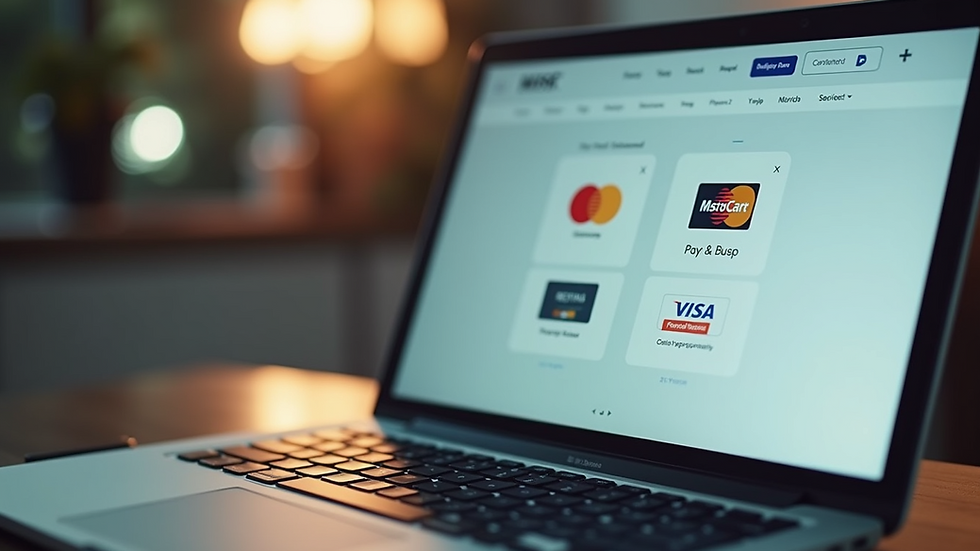Secure Online Payments for Safe Shopping
- bcstylecrafts
- Sep 7
- 5 min read
In today’s digital landscape, online shopping has become an everyday occurrence. As convenient as it is, the rising frequency of online transactions brings with it a pressing concern: security. Safe shopping transactions hinge on the method of payment chosen. The effectiveness of fraud prevention measures can significantly impact the security of these payments. With that in mind, it's crucial to partner with reliable platforms that prioritize the protection of your information. This article provides insights and best practices for implementing secure online payments.
Safe Shopping Transactions
When engaging in online shopping, securing your payment details is essential. Many consumers underestimate the importance of safeguarding their financial information while shopping online. According to a report from Statista, credit card fraud alone amounted to approximately $28.71 billion in losses in 2022, up from $22.43 billion in 2021. This statistic serves as a stark reminder of the risks involved in online transactions.
Reputable online retailers and secure payment platforms invest in robust security measures that ensure safe shopping transactions. For instance, many websites now use Secure Socket Layer (SSL) technology to encrypt sensitive information shared during the checkout process. This means that your credit card information and personal details are transformed into a code that cannot be easily deciphered by malicious actors.

It’s essential to look for indicators of security when making a purchase. One such indicator is the presence of a padlock icon in the address bar of your web browser. This symbol confirms that the site you are using is encrypted. Additionally, before entering personal information, verify that the URL begins with “https://” rather than “http://”. The additional “s” stands for “secure,” indicating that the website has taken steps to protect your data.
Payment Methods for Secure Online Transactions
Choosing the right payment method is vital for secure online payments. Each payment option comes with its own set of pros and cons regarding safety and convenience. Below are some of the most common methods:
Credit and Debit Cards: These are the most widely used payment methods for online shopping. Credit cards often come with fraud protection features that allow users to dispute charges and get reimbursed if fraudulent activity occurs.
Digital Wallets: Services like PayPal, Apple Pay, and Google Pay offer enhanced security as your payment details are not directly shared with the retailer. Instead, they work as intermediaries, encrypting your data and keeping your sensitive information hidden.
ACH Transfers: Automated Clearing House (ACH) transfers allow for direct bank to bank transactions. While typically considered safe due to bank verification processes, they can still expose your account number if not properly secured.
Cryptocurrencies: Cryptocurrencies like Bitcoin provide anonymity and secure payments through blockchain technology. However, they can be volatile and not widely accepted, making them less practical for everyday shopping.

When selecting a payment method, consider the level of protection it offers. Credit cards provide greater fraud protections compared to debit cards. However, for those who prefer not to share their card information online, digital wallets can be an excellent alternative.
Which is Safer, an ACH or a Debit Card?
When weighing the safety of ACH transfers against debit cards, several factors come into play. ACH transfers involve routing numbers and account numbers, which could be vulnerable if shared carelessly. However, one major advantage of ACH is that it often includes built-in fraud monitoring by banks.
On the other hand, debit cards link directly to your checking account. While they can be convenient, the lack of strong protections against fraud makes them risky. If someone gets hold of your debit card information, they could drain your bank account considerably faster than they could charge up a credit card, where you can often dispute charges more easily.
Statistics indicate that while debit card fraud losses were significant, credit card fraud losses were more pronounced in 2022. According to the Federal Trade Commission (FTC), consumers reported losing over $1.48 billion to various fraud schemes—dollars that could have been safeguarded with prudent payment choices.
Additionally, using an ACH transfer typically keeps your credit card and financial information more private, which is vital for privacy-conscious shoppers.

Ultimately, the choice between ACH and debit cards depends on your personal preferences and comfort levels with risk. Understanding these nuances will help you make informed decisions about which services to use for your transactions.
Signs of Secure Online Shopping Sites
Navigating the online shopping landscape can feel overwhelming, especially with the prevalence of digital fraud. There are several telltale signs to look for when identifying whether a shopping site is secure:
Look for SSL Certificates: As mentioned, check for the padlock icon in the URL. Clicking on it will show you the site's security certificate.
Read Customer Reviews: Websites that are trustworthy will have expansive reviews from previous shoppers. Authentic feedback can provide insights into other users’ experiences.
Verify Contact Information: A legitimate business will be transparent, often displaying their contact information readily. Be wary of sites that provide little to no customer support.
Payment Protection Policies: Ensure the site has clear policies demonstrating how they protect customer transactions. Most reputable sites explicitly outline their security measures.
Two-Factor Authentication (2FA): If the shopping site offers an option for 2FA, take advantage of it. This optional step adds an extra layer of security by requiring another form of identification in addition to your login credentials.

By spotting these indicators, shoppers can better judge the security level of the websites they visit. It is always wiser to err on the side of caution when dealing with online transactions.
Best Practices for Secure Online Payments
To ensure that your online payments remain secure, consider the following best practices:
Update Software Regularly: Keep your browser, antivirus, and operating systems up to date to protect against vulnerabilities that could be exploited by cybercriminals.
Use Strong Passwords: Create strong and unique passwords for each account, and change them regularly. Consider using a password manager to help keep track of them.
Be Cautious with Wi-Fi: Avoid making payments when connected to public Wi-Fi networks, as they can often be less secure. If you must use public Wi-Fi, employ a Virtual Private Network (VPN) for added protection.
Monitor Bank and Credit Card Statements: Regularly check your financial statements for any unauthorized transactions. Prompt reporting of fraud can make it easier to recover any lost funds.
Educate Yourself about Phishing Scams: Learning to recognize phishing emails, which often masquerade as legitimate sources, can protect you from inadvertently providing your data to scammers.
By implementing these practices into your online shopping habits, you can significantly enhance your security while enjoying a seamless shopping experience.
Your Path to Safer Online Transactions
The evolving landscape of e-commerce brings with it challenges and opportunities. While threats to online safety exist, consumers have more resources available than ever before to ensure secure online payments. By familiarizing yourself with online security measures and adopting best practices, shoppers can enjoy the many benefits of online shopping without the fear of fraud.
Navigating through the world of safe online transactions doesn’t have to be overwhelming. By knowing the right payment methods to use and being aware of the signs of a secure shopping site, you can make informed choices. Your financial safety is paramount, so prioritize it when making online purchases. Let’s commit to building a safer online shopping community together.
Please ensure you stay informed and vigilant about your online shopping habits. For more in-depth information on secure online payments and store policies, you can refer to this link.












Comments